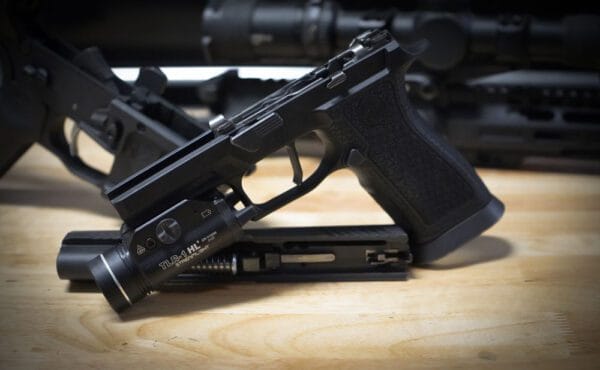
On the heels of the Bureau of Alcohol, Tobacco, Firearms and Explosives (ATF) pistol brace rule (2021R-08F) being struck down by a federal court in Texas, its other significant rule change has also been knocked down. The Fifth Circuit Court of Appeals has now vacated the two main provisions of the ATF frame and receiver rule (2021R-05F).
The Firearms Policy Coalition (FPC) brought the case, VanDerStok v. Garland, challenging certain aspects of the rule that changed the factoring criteria for firearms with attached “stabilizing braces.” In addition to FPC, the plaintiffs included Jennifer VanDerStok, Michael Andren, Tactical Machining, Blackhawk Manufacturing Group (d/b/a 80 Percent Arms), Defense Distributed, Not An L.L.C (d/b/a JSD Supply), Second Amendment Foundation (SAF), and Polymer80. All the plaintiffs claimed that the ATF was overstepping its power and making a de facto law.
A panel of three judges from the Fifth Circuit Court of Appeals felt that the ATF was trying to usurp the powers of Congress by making de facto laws through the federal rule-making process. Redefining what constitutes a firearm takes the power away from the legislative branch. The ATF is there to enforce the laws and not make laws. The Fifth Circuit Court clearly believed that the ATF was trying to act as lawmakers.
“It has long been said—correctly—that the law is the expression of legislative will. As such, the best evidence of the legislature’s intent is the carefully chosen words placed purposefully into the text of a statute by our duly-elected representatives. Critically, then, law-making power—the ability to transform policy into real-world obligations—lies solely with the legislative branch. Where an executive agency engages in what is, for all intents and purposes, “law-making,” the legislature is deprived of its primary function under our Constitution, and our citizens are robbed of their right to fair representation in government. This is especially true when the executive rule-turned-law criminalizes conduct without the say of the people who are subject to its penalties,” Circuit Judge Kurt D. Engelhardt wrote.
Because the Circuit Court considered the ATF’s actions illegal, the Court vacated the challenged portions of the rule (ATF’s proposed definition of “frame or receiver,” including incomplete frames and receivers, and ATF’s proposed definition of “firearm,” including weapon parts kits). The Court believed that the ATF could not criminalize previously legal conduct. Many believe the rule was to appease the anti-gun groups that made significant donations to the Biden campaign.
“The agency rule at issue here flouts clear statutory text and exceeds the legislatively-imposed limits on agency authority in the name of public policy. Because Congress has neither authorized the expansion of firearm regulation nor permitted the criminalization of previously lawful conduct, the proposed rule constitutes unlawful agency action, in direct contravention of the legislature’s will. Accordingly, for the reasons set forth below, we AFFIRM IN PART and VACATE AND REMAND IN PART the judgment of the district court,” the decision read.
The ATF claimed that changing the definition of frames and receivers was necessary because of emerging technology. The Fifth Circuit Court of Appeals took the same approach as SCOTUS in the Bruen case. They examined the plain language of the Gun Control Act of 1968 (GCA) and the historical definition of frames and receivers.
“After almost fifty years of uniform regulation, ATF, via the Final Rule, now purports to expand the terms’ frame’ and ‘receiver,’ as they were understood in 1968, to include changes in firearms in modern times. But the meanings of statutes do not change with the times,” the judges wrote.
The Court also agreed that the District Court made the correct decision when it ruled that the ATF does not have the authority to regulate gun parts. The ATF used the Federal Firearms Act (FFA), which was replaced by the Gun Control Act of 1968 (GCA). The Court ruled that the ATF might have had the authority under the FFA, but the GCA removed that authority from the ATF.
“The district court correctly held that ATF has no authority whatsoever to regulate parts that might be incorporated into a ‘firearm’ simply because Congress explicitly removed such authority when it enacted the GCA. The GCA’s predecessor statute, the Federal Firearms Act (‘FFA’), had specific language that authorized regulation of ‘any part or parts of’ a firearm,” the decision read.
The Court also believed the ATF was trying to “do something” because Congress didn’t act on PMFs.
Once again, the court reminded the ATF that it cannot make laws no matter what the President wants. This ruling was a rebuke to the Biden Administration’s strategy for gun control. With the Circuit Court decision in Cargill and the lower Court’s decision in knocking down the pistol brace rule, the ATF’s desire to change laws is in jeopardy.
“ATF, in promulgating its Final Rule, attempted to take on the mantle of Congress to ‘do something’ with respect to gun control. But it is not the province of an executive agency to write laws for our nation. That vital duty, for better or for worse, lies solely with the legislature. Only Congress may make the deliberate and reasoned decision to enact new or modified legislation regarding firearms based on the important policy concerns put forth by ATF and the various amici here. But unless and until Congress so acts to expand or alter the language of the Gun Control Act, ATF must operate within the statutory text’s existing limits. The Final Rule impermissibly exceeds those limits, such that ATF has essentially rewritten the law. This it cannot do, especially where criminal liability can—and, according to the Government’s own assertions, will—be broadly imposed without any Congressional input whatsoever. An agency cannot label conduct lawful one day and felonious the next—yet that is exactly what ATF accomplishes through its Final Rule. Accordingly, the judgment of the district court is AFFIRMED to the extent it holds unlawful the two challenged portions of the Final Rule, and VACATED and REMANDED as to the remedy,” the Court ordered.
There is a stay by the Supreme Court of the United States on the previous preliminary injunctions. Only Polymer80’s injunction remains without a stay.
Some legal scholars believe that this stay precludes this decision. Even if that is the case, the rule is dead if the SCOTUS doesn’t grant a writ of certiorari to the ATF. If SCOTUS does decide to hear the case, it might be until SCOTUS issues an opinion to kill the rule for good.
One of the plaintiffs, JSD Supply, spoke to AmmoLand News about the ruling. The President of JSD Supply, Jordan Vinroe, was excited about the opinion and looked forward to the Supreme Court’s decision.
“We are excited about the 5th circuit’s order today,” Vinroe said. “They made the correct decision in vacating the frames and receiver rule. We expect the same outcome if the Supreme Court hears the arguments as well.”
The higher court has remanded the case to the District Court to issue the appropriate remedy. The ATF could ask for the Fifth Circuit Court of Appeals for an en banc hearing where the full bench would hear the case, but the Court’s previous rulings show that isn’t a path for an ATF victory. The ATF’s only hope to save the rule is SCOTUS.
Fifth Circuit Court of Appeals Vacates ATF Frames and Receiver Rule by AmmoLand Shooting Sports News on Scribd
About John Crump

from https://ift.tt/GI3ysHu
via IFTTT

No comments:
Post a Comment